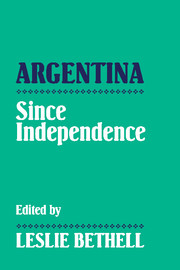Book contents
- Frontmatter
- Contents
- List of maps
- Preface
- 1 From independence to national organization
- 2 The growth of the Argentine economy, c. 1870–1914
- 3 Society and politics, 1880–1916
- 4 Argentina in 1914: The pampas, the interior, Buenos Aires
- 5 From the First World War to 1930
- 6 Argentina, 1930–1946
- 7 Argentina since 1946
- Bibliographical essays
- Index
7 - Argentina since 1946
Published online by Cambridge University Press: 09 November 2009
- Frontmatter
- Contents
- List of maps
- Preface
- 1 From independence to national organization
- 2 The growth of the Argentine economy, c. 1870–1914
- 3 Society and politics, 1880–1916
- 4 Argentina in 1914: The pampas, the interior, Buenos Aires
- 5 From the First World War to 1930
- 6 Argentina, 1930–1946
- 7 Argentina since 1946
- Bibliographical essays
- Index
Summary
THE PERONISTA DECADE, 1946–55
On 24 February 1946 General Juan Domingo Perón was elected president of Argentina in an open poll. This victory was the culmination of his dizzying political rise, which had begun a few years earlier when the military revolution of June 1943 put an end to a decade of conservative governments and brought to power a clique of army colonels with fascist sympathies. The emerging military regime had been groping its way between the hostility that its authoritarian and clerical tendencies had awakened in the middle and upper classes and the diplomatic quarantine organized by the United States in reprisal for Argentina's neutral position in the Second World War. Through clever palace manoeuvring Perón became the regime's dominant figure and ended the political isolation of the military elite by launching a set of labour reforms that had a powerful impact on the working class, whose numbers had swelled with industrialization and urbanization since the mid-1930s. In Perón's vision, the function of these reforms was to prevent the radicalization of conflicts and the spread of Communism. But the Argentine bourgeoisie did not fear an imminent social revolution, a fear which, at other times and in other places, had facilitated the acceptance of similar reforms. As a result, they joined the anti-fascist front organized by the middle class, imbuing political cleavages with a visible class bias.
In 1945, the new climate created by the imminent triumph of the Allied forces led the military authorities to look for an institutional solution.
- Type
- Chapter
- Information
- Argentina since Independence , pp. 243 - 364Publisher: Cambridge University PressPrint publication year: 1993
- 6
- Cited by

